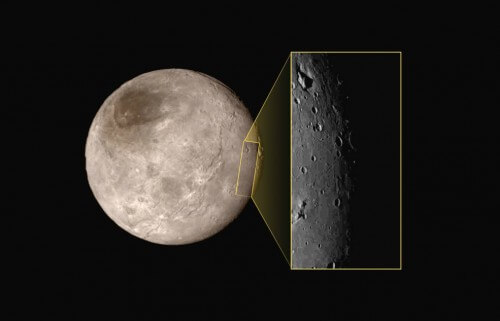A rectangle with a detailed photograph of an area on Charon, revealing rare signs in the solar system

After the photograph of Pluto that revealed a chain of mountains at a height of 3500 meters, it was Charon's turn.
A new image broadcast by the New Horizons spacecraft from the images it took during its quick pass by Pluto and Charon on Shrove Tuesday, reveals an interesting route - a valley with a mountain peak in the center, visible here on the upper left in the highlighted rectangle.
The picture shows an area that is about 390 kilometers long from top to bottom and several craters can be seen in it. "The most intriguing configuration is a large mountain sitting inside a shield trench," says Jeff Moore of NASA's Ames Center in California, who heads the geology, geophysics and imaging team. "This formation left the geologists in shock."
The image provides a glimpse of what we are likely to see on this large moon in the many photographs taken by the New Horizons spacecraft during the transit. This image is very compressed. Sharper versions are expected to arrive when all the data from the Long Range Reconnaissance Imager (LORRI) reaches Earth.
The overlaid rectangle on the full Charon photograph shows the estimated location of this close-up.
The photo was taken about an hour and a half before the approach to Pluto, from a distance of 79 thousand kilometers.
The mall nominated for the title of the largest mall in the solar system
A previous photo of Charon that was revealed yesterday shows a canyon estimated to be 7-9 kilometers deep and stretching for hundreds of kilometers. It may compete for the title of longest canyon in the solar system.
A chain of young mountains and a variety of landscapes were also observed in Karon. The scientists were surprised by its appearance without impact craters. A strip of craters and depressions stretching for about a thousand kilometers, indicates an extensive crack in Charon's crust, most likely as a result of an internal geological process.
In the north pole area of Charon there are dark areas where the border between them and the light areas is blurred, which indicates a thin layer of stain on the surface.
More on the subject on the science website"
- Surprising discovery: New Horizons photographed young mountains on Pluto and Charon
- New Horizons "phoned home" to announce that it survived the transit near Pluto * The photos will arrive in a trickle over the next year and a half
- Images of Pluto and Charon taken by New Horizons in artificial colors highlight the enormous variety of terrain trajectory on these two worlds
- NASA is celebrating the passage of New Horizons at the closest point to Pluto and is waiting to renew contact with it early in the morning
- Technion researchers have proposed a model for finding new moons for Pluto, awaiting New Horizons photographs
- New Horizons revealed: Pluto's diameter is 2,370 km
- New Horizons approaches Pluto - photographed the enigmatic dark spots
- Discoverer of Pluto, the girl who gave him his name and the actor Leonard Nimoy will be commemorated on Pluto and Charon
- A historic meeting
- A whale on Pluto
- Pluto - a point of light in the darkness

2 תגובות
A question for the physicists
Following on from Nate's suggestion, given Pluto's small size and weak gravity, is it possible for a scenario of an asteroid hitting the planet at a very, very sharp angle to "scratch" its surface without creating a crater?
To me, to an unprofessional eye, this mountain looks like a slow and gentle impact on the surface of an asteroid.
How does that happen? This is a question for physicists, but it is possible that it emerged at a relatively low speed from behind, was captured by gravity, and fell to the ground.